What is Keyword Clustering?
Keyword clustering is the process of grouping the number of keywords in your content to rank higher. Keywords are the most important factor for a high-ranking website or content. Many SEO experts will focus on only one keyword for their whole content. It is not advisable and not a practical one for ranking. Why do you need to focus only on one? There are a greater number of related keywords for your focus keyword.
Keyword research is the first process to cluster your group of keywords. To grow your organic search, you need to plan, organize, and map your keywords in the content.
Are you looking to improve your organic traffic? Then, you should think of “product/market fit”. Let us assume Keyword Research as the market, content as the product, and fit as the optimization. This may be difficult for many people to understand, so we will explain this in simple words,
Market – What people are searching for (keyword research)
Product – What people are consuming (content)
Fit – Optimizing your keyword for both the searches and content
In this article, we will discuss, how to use keyword clustering to optimize your content. To use keyword clustering, first, you need to understand what keyword clustering is. Let us divide the process into five parts,
- Keyword Collection
- Term Analysis
- Hot Words
- Preparation for Keyword Grouping
- Keyword Grouping
With these 5 steps, you can completely understand the process of keyword clustering. You can implement this to rank your content higher in a user-friendly manner.
Keyword Collection
Collecting the related keywords is the first process to cluster your keywords. Find all the possible keywords for your content marketing and your focused keyword and store them in a datasheet. This collection will help you to avoid unwanted and unrelated keywords. This process is commonly called filtering, filter your keywords for better reach. After filtering, you would have a limited number of long-tail keywords (always choose long-tail keywords).
For example, if you are working on a client project, you can collect 1000 to 6000 keywords, and sometimes you can get more than 10,000 keywords or less than 1000 keywords. It is advisable to search at least 8 to 12 different sites for collecting the keywords, you should spend a minimum of 1 hour collecting them.
For example, if you are working for the pest control sites, you can get relevant and related keywords from,
- Your competitor websites
- Keyword Research tools like Ahrefs, Semrush, and Moz
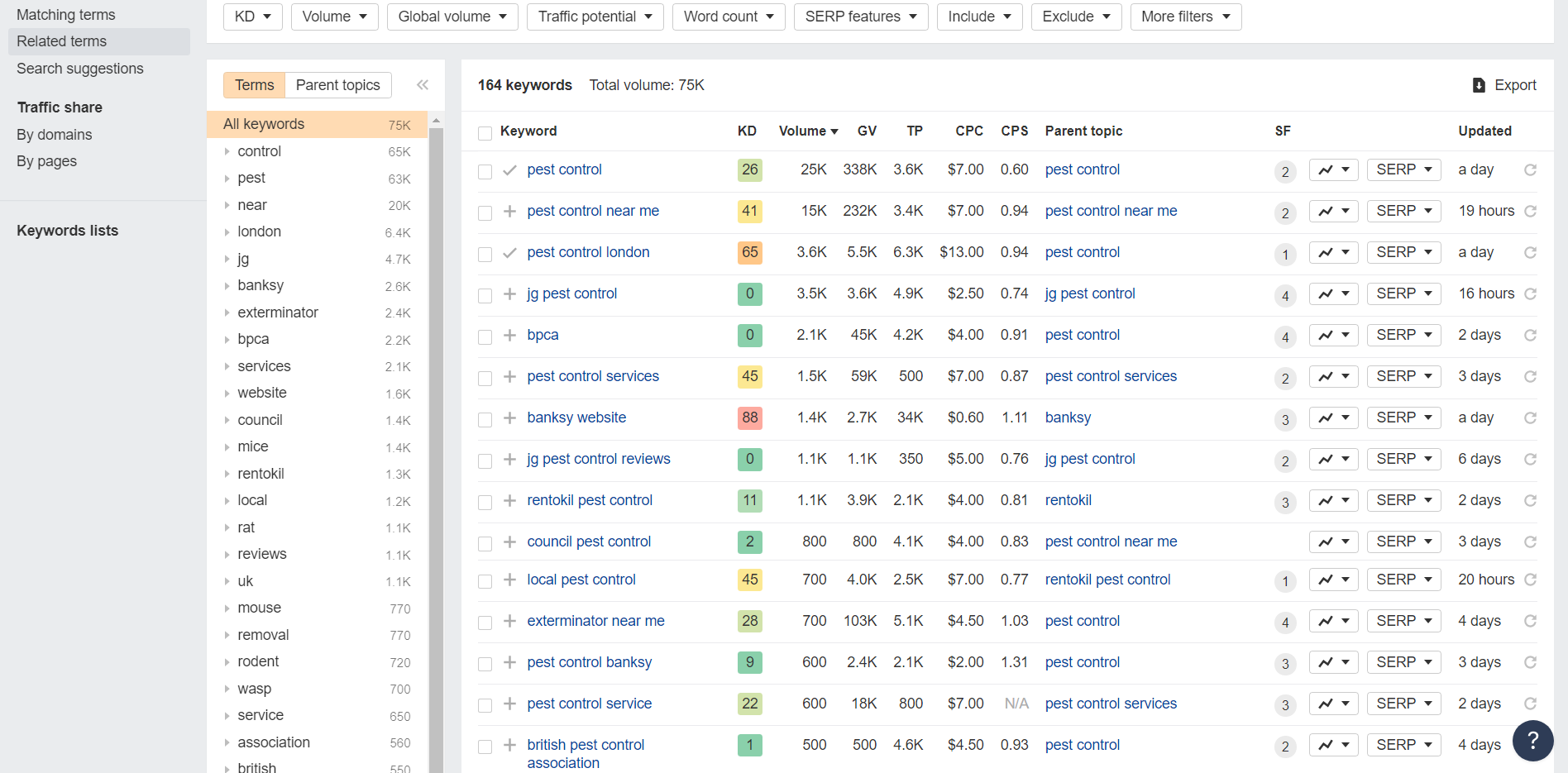
- Search for the existing data in Google Search Console and Google Analytics
- Take keywords from the Google search suggestions
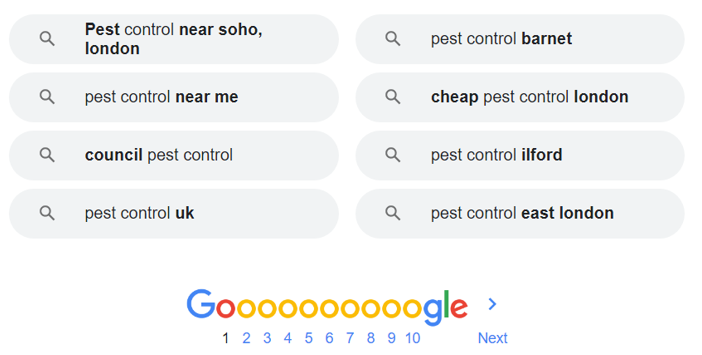 Term Analysis
Term Analysis
The phrase ‘Term Analysis’ means that you need to separate the focus keyphrase into each word. You could have a greater number of keywords in your research list.
For example,
- Pest Control near me
- Pest control Barnet
- Council Pest Control
- Pest Control UK
- Pest Control East London
These are 5 keyphrase suggested by Google. Separate the first one ‘pest’, ‘control’, ‘near’, ‘me’ you can notice that ‘near’ and ‘me’ are the support words for ‘pest control’ which is then repeated words in all the keywords. It is important to add these words in your selected keywords, exclude all the grammars, prepositions, and conjunctions. Give importance to the repeated words, and make a keyword with better search volume, less difficulty, and a long tail keyword.
Instead of using a single word, the two-word or three-word phrase can give you a better result. This term analysis helps you ignore the unwanted words and add important keywords.
Hot Words
Hot words are the words or phrases which are considered important in the above section for example ‘pest control’. You can avoid the unwanted words with which you do not have any improvements. With these hot words, you can build a high ranking keyword with better search volume and difficulty.
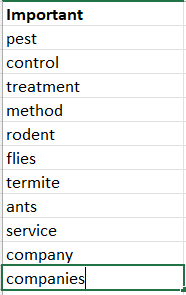 When working on the client’s site, you need an answer for the below 3 questions from the listed keywords. You can give a better keyword or keyphrase with your client’s advice.
When working on the client’s site, you need an answer for the below 3 questions from the listed keywords. You can give a better keyword or keyphrase with your client’s advice.
- Which of these are important for your business?
- Which of these are negative keywords or need to be ignored?
- Feedback about the highly qualified keywords
After getting the answers you align the required keywords in a datasheet.
Preparation for Keyword Grouping
For this preparation, make use of Google Sheets which is effective for planning. First copy all the hot words and paste them in a Google Sheet with a special option ‘Transposed’. If you cannot use this option, then paste normally and you should insert all the variables manually.
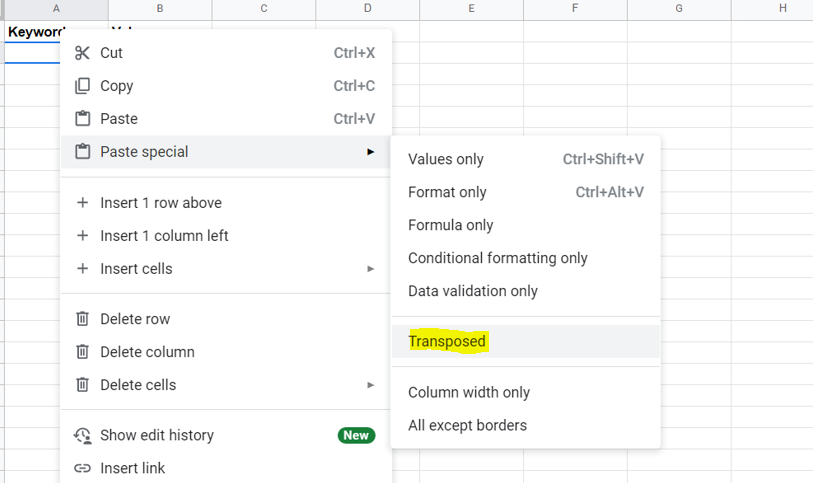 This option will help you to filter the required words. List all the keywords with the required elements like healthy, normal, buy, etc., Use the words ‘YES’ and ‘NO’ to identify the nature of keywords.
This option will help you to filter the required words. List all the keywords with the required elements like healthy, normal, buy, etc., Use the words ‘YES’ and ‘NO’ to identify the nature of keywords.
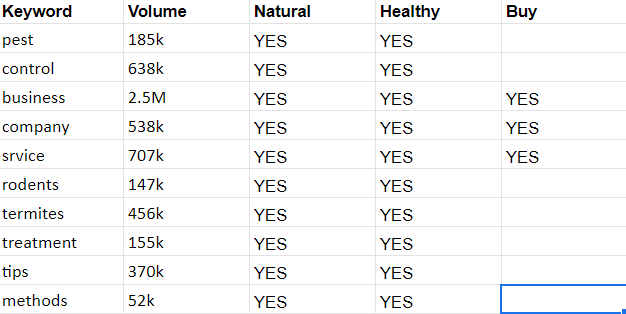 Now remove all the Nos and you will get a limited number of keywords.
Now remove all the Nos and you will get a limited number of keywords.
Keyword Grouping
Consider the above-listed keywords and merge the appropriate words with a proper phrase.
For example, ‘pest control company’ and ‘pest control service’. After merging check the volume and difficulty of the new keywords.
 Now you can see the desired result of the selected keyword. This is done for a single keyword, follow these steps for a greater number of keywords as much as possible. The more the keywords in your website or content, your site will be ranked quickly and reach the required organic traffic.
Now you can see the desired result of the selected keyword. This is done for a single keyword, follow these steps for a greater number of keywords as much as possible. The more the keywords in your website or content, your site will be ranked quickly and reach the required organic traffic.
Benefits of Keyword Clustering
- Increases Visibility in SERP
- Content will be better for the readers
- A better digital marketing strategy with increased productivity in business
- Reduce the risk in crawling and indexing
- Longer scalability as a better SEO ranking strategy
Now, we have grouped the keywords successfully with a good result. Let us learn how to use this to optimize your content.
How to Use Keyword clustering to Optimize your Content?
1. SERP analysis
To rank your page, business website, or the content on the first page or the top results, first, you need to find what Google displays. Add the required niches in your content which is useful for ranking. If you are ranking for an article or service page, search with the relevant keyword.
For example, if you are ranking your pest control website or content, first make a search with the desired keyword or topic, I’ll take ‘Rodent Control Methods’.
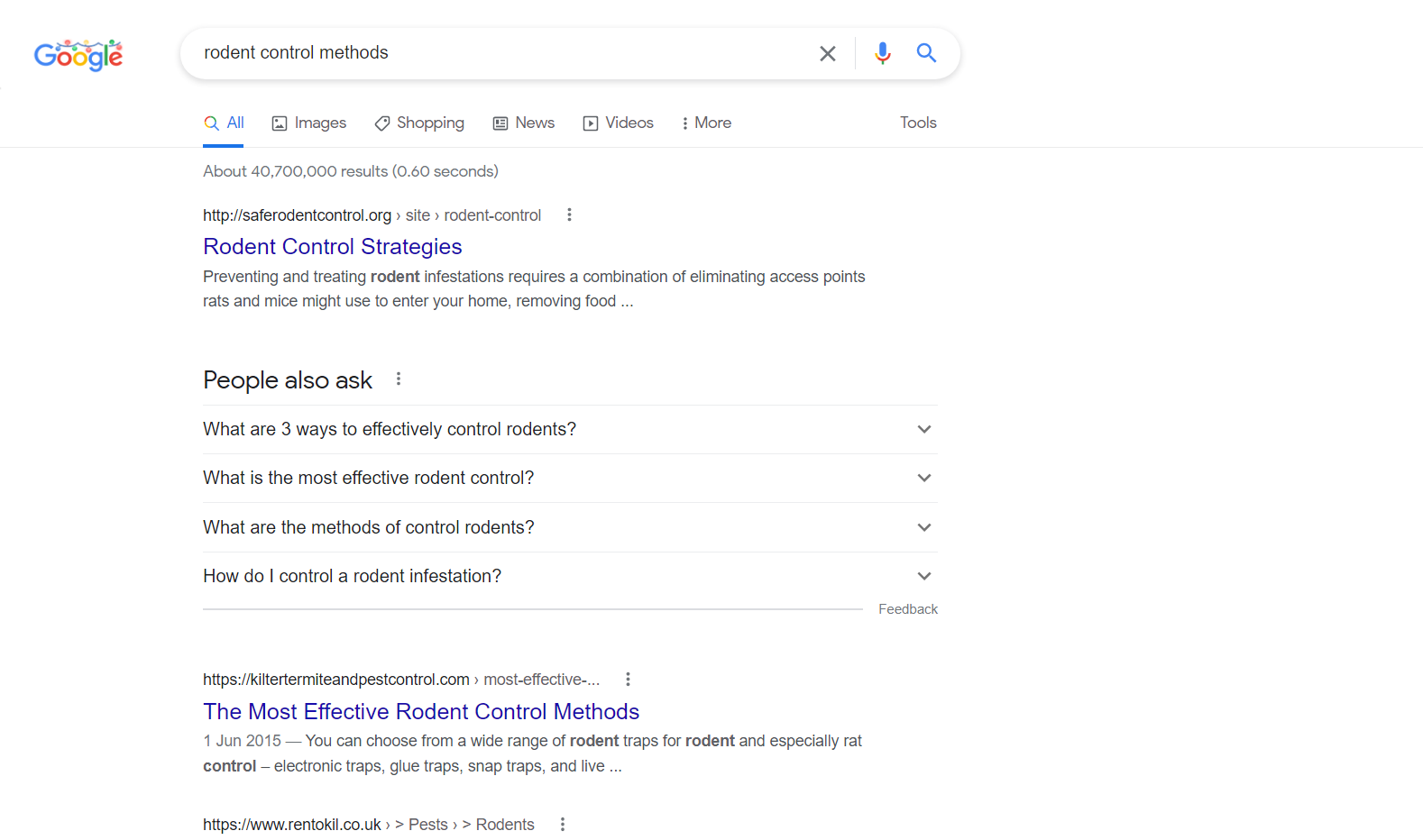 You can see the results like this, domain ranking and the loading time are the main features for an article to rank. You can notice the ‘People also ask’ section, try to include those questions and answer in your own way. If you have any video for the article, embed the code in the content which can act as the ranking factor.
You can see the results like this, domain ranking and the loading time are the main features for an article to rank. You can notice the ‘People also ask’ section, try to include those questions and answer in your own way. If you have any video for the article, embed the code in the content which can act as the ranking factor.
Note: Featured snippets, videos, images, keywords in the image alt text, answers for the PAA are the major ranking factors for a new article.
2. Choose the most appropriate keyword
Avoid stuffing irrelevant keywords for your content. Make use of the keywords you grouped and add them to your content as much as possible. Internal Link is one the best-ranking factor, select the appropriate ‘anchor text’ and give the absolute link present in your site.
For example, if you are working on a pest control site, you need to give a link to your home page. You can select the anchor text like ‘pest control service’ and ‘pest control company’, or you select the name of the website if it is included.
3. Avoid Cannibalization
Cannibalization is the reduction of an existing product by introducing the new same product, in terms of product selling. In digital marketing, cannibalization means the same URLs, keywords, topics in the different sites. If you are already ranking for a keyword, but your competitor has acquired a better result than you with the same keyword, it is called cannibalization.
To avoid this, you should cut your content into two halves, and focus on the two different keywords with high search volume. You can select the appropriate keywords from your keyword clustering with less difficulty and high search volume. Or you can use the first two SERPs from Google for the appropriate keyword.
4. Keyword Clustering streamline the SEO
Keyword clustering is a long-term process, this helps to rank your websites in present and future. Having the number of clustered keywords in your website will give way to creating new content for the desired keywords. Keyword clustering is one of the better SEO tips and strategies to have a stable high-ranking website for a greater number of days.
Conclusion
Keyword clustering act as the heart of any website to rank higher and to reach the targeted audiences. A website without keyword clustering is like a meal without any taste. You should spend your own time for keyword clustering by using SERPs, google suggestions, also you can use the online Keyword research tools. The time you spend will not be wasted instead, keyword clustering will give a better result for long days.





































